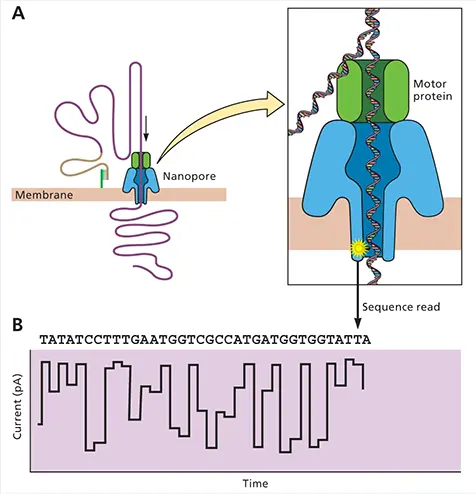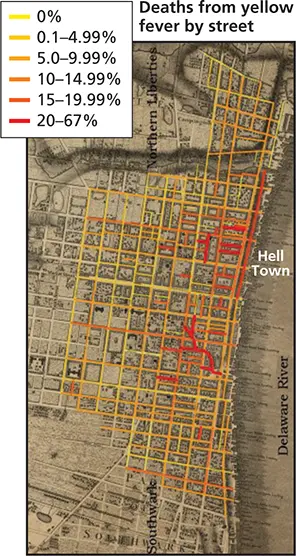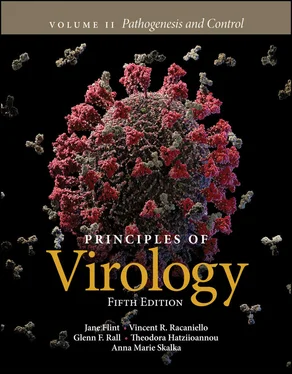S. Jane Flint - Principles of Virology, Volume 2
Здесь есть возможность читать онлайн «S. Jane Flint - Principles of Virology, Volume 2» — ознакомительный отрывок электронной книги совершенно бесплатно, а после прочтения отрывка купить полную версию. В некоторых случаях можно слушать аудио, скачать через торрент в формате fb2 и присутствует краткое содержание. Жанр: unrecognised, на английском языке. Описание произведения, (предисловие) а так же отзывы посетителей доступны на портале библиотеки ЛибКат.
- Название:Principles of Virology, Volume 2
- Автор:
- Жанр:
- Год:неизвестен
- ISBN:нет данных
- Рейтинг книги:3 / 5. Голосов: 1
-
Избранное:Добавить в избранное
- Отзывы:
-
Ваша оценка:
- 60
- 1
- 2
- 3
- 4
- 5
Principles of Virology, Volume 2: краткое содержание, описание и аннотация
Предлагаем к чтению аннотацию, описание, краткое содержание или предисловие (зависит от того, что написал сам автор книги «Principles of Virology, Volume 2»). Если вы не нашли необходимую информацию о книге — напишите в комментариях, мы постараемся отыскать её.
Volume I: Molecular Biology
Volume II: Pathogenesis and Control
Principles of Virology, Fifth Edition
Principles of Virology, Volume 2 — читать онлайн ознакомительный отрывок
Ниже представлен текст книги, разбитый по страницам. Система сохранения места последней прочитанной страницы, позволяет с удобством читать онлайн бесплатно книгу «Principles of Virology, Volume 2», без необходимости каждый раз заново искать на чём Вы остановились. Поставьте закладку, и сможете в любой момент перейти на страницу, на которой закончили чтение.
Интервал:
Закладка:
Viral Epidemics in History
In the apocalyptic movies I Am Legend (2007), Contagion (2011), and World War Z (2013), fictional epidemics are depicted following introduction of a virus into a naïve human population. (In some of these films, the virus turned the infected victims into zombies; although viruses cause many diverse outcomes, zombification is not among them.) Some of these doomsday films include a scene in which an epidemiologist ominously describes the devastating consequences of uncontrolled, exponential viral spread through a population. These movies were certainly frightening, but ultimately comforting, as humans, with improbable speed, developed strategies to limit viral spread. But how realistic is this Hollywood vision? One could argue that proof of our triumph over viral pathogens can be found in the eradication of smallpox and the development of vaccines to prevent infection by many viruses that historically resulted in much sickness and loss of life. However, there is a risk in becoming self-congratulatory. Doing so makes us ignorant of how quickly a virus can spread in a susceptible population, as the recent SARS-CoV-2 pandemic has taught us. When epidemics and pandemics occur in real life, there is a pervasive feeling of helplessness, and often interventions are not developed in time to mitigate substantial clinical impact. The stories that follow highlight the financial toll, loss of life, and historical ramifications of viral outbreaks, and underscore a new reality: the increased mobility of human and animal populations on the planet has almost certainly accelerated the emergence of epidemics.
BOX 1.3
METHODS
Nanopore sequencing
A new approach for determining the sequence of a nucleic acid has been developed, referred to as “nanopore sequencing.” This method relies on the use of biological nanopores, such as the bacterial hemolysin, which forms extremely small holes, or pores, in a membrane. These pores have a diameter wide enough to allow only a single strand of RNA or DNA to pass through. When an ionic current is applied to the membrane, each of the four nucleotides passing through the pore alters the current in a characteristic manner, which can be interpreted by a sensor (yellow starburst in panel A in the figure) and de coded to provide the sequence. This approach obviates the need for PCR amplification, greatly reducing experimental error that can accompany other sequencing techniques that rely on such amplification. Moreover, this approach is portable to remote locations, accelerating pathogen identification at sites of outbreaks.
Kafetzopoulou LE, et al. 2019. Metagenomic sequencing at the epicenter of the Nigeria 2018 Lassa fever outbreak. Science 363:74–77.

Simplified overview of the process of nanopore sequencing.
Epidemics Shaped History: the 1793 Yellow Fever Epidemic in Philadelphia
One powerful example of a deadly viral epidemic that influenced American history and changed how cities are managed is the yellow fever outbreak that occurred in Philadelphia, Pennsylvania. In 1793, when this epidemic occurred (and a full century before Walter Reed’s commission), nothing was known about yellow fever virus, the disease, or how it was spread. Worse, no one at the time knew that viruses existed, so the seemingly random way that individuals became sick com pounded the confusion and sense of helplessness. Further-more, this epidemic struck at a pivotal time for the fledgling Union. At that time, Philadelphia was the new nation’s temporary capital and a city of active commerce and trade. One can easily imagine the panic in Philadelphia when scores of individuals became ill and died of this mysterious disease within a very short time. In the 101 days between August 1 and November 9, some 5,000 people perished in a city of about 45,000, making this one of the most severe epidemics in the history of the United States ( Fig. 1.4). There were few families that did not lose a relative to this disease, and many entire families were lost. Those who could flee the city did so, including the new president, George Washington, and his cabinet. Others stayed behind to aid the sick, including men of the Free African Society, who volunteered on the basis of the incorrect notion of Benjamin Rush, a prominent Philadelphia physician, that black people were immune to infection.

Figure 1.4 Deaths caused by the yellow fever epidemic in Philadelphia, 1793. This map records the locations of deaths due to yellow fever, with red and orange streets marking those with highest mortality. Yellow fever was most deadly near the northern wharves, where poorer people lived, and where Hell Town was located (just blocks away from Independence Hall and the current home of the Liberty Bell). These areas furnished breeding places for Aedes aegypti , the species of mosquito that transmits the disease. Adapted from Paul Sivitz and Billy G. Smith, with permission.
Because Philadelphia was a major port city, it is likely that the agent, which we now know was the yellow fever virus, was transported by infected individuals on cargo ships, and that standing water in the city provided a hospitable breeding ground for local mosquitos and rapid expansion of the disease along the wharves. Credit goes to Rush, who noticed identical symptoms in many victims and who recommended that individuals either leave the city or quarantine themselves, practices that helped to curtail the epidemic. Rush’s belief that the scourge arose from a pile of rotting coffee beans left on a dock, and his treatment regimen of purging and bloodletting, are less worthy of praise.
The city of Philadelphia was transformed after the epidemic. The outbreak, believed by many to be due to contaminated water (which was, in part, true), spurred the local government to establish a municipal water system, the first major city in the world to do so. Infirmaries to tend to the sick and isolate them from the healthy were developed. Finally, the epidemic promoted a city-supported effort to keep streets free of trash, leading to the development of a sanitation program that would be a model for similar programs elsewhere. Although an effective vaccine now exists, yellow fever still kills 30,000 people every year, about 90% of them in Africa.
Tracking Epidemics by Sequencing: West Nile Virus Spread to the Western Hemisphere
It took a full century to determine the cause of the Philadelphia epidemic, but technological advances have greatly accelerated our ability to understand the natural histories of some modern-day outbreaks. While the sudden appearance of West Nile virus in the Western Hemisphere in 1999 fortunately did not result in massive loss of life, this epidemic is notable for the role that viral genome sequencing played in defining its origin in the Middle East.
Prior to the summer of 1999, West Nile virus infections were restricted to Africa and the Mediterranean basin. Upon introduction to the United States, West Nile virus spread with remarkable speed; in 3 years, the incidence of infection expanded from eight cases in Queens, New York City, to virtually all of the United States and much of Canada, where it is now endemic ( Fig. 1.5).
The eight cases first identified in Queens held the key for major epidemiologic efforts to identify the source of this new infection. All victims had been healthy, and many had engaged in outdoor activities soon before showing signs of sickness. At about the same time, a high proportion of dead birds was found in and around New York City, including exotic birds within the Bronx Zoo, prompting epidemiologists to consider the possibility that the same virus had infected both hosts. PCR and genome sequencing were used to confirm that West Nile virus was the cause of both the bird deaths and the human illnesses. Subsequently, it was discovered that the virus was rapidly disseminated among avian and mammalian populations, and that mosquitos (again) were the vector that transmitted the virus to mammals, including humans. Fortunately, the consequences of infection are far less severe than for yellow fever: in 2009, 720 cases were diagnosed, but epidemiologists believe the true number to be >54,000; the discrepancy is likely due to the mild symptoms that the infection causes in most healthy individuals. Most deaths occur in the immunocompromised and the elderly.
Читать дальшеИнтервал:
Закладка:
Похожие книги на «Principles of Virology, Volume 2»
Представляем Вашему вниманию похожие книги на «Principles of Virology, Volume 2» списком для выбора. Мы отобрали схожую по названию и смыслу литературу в надежде предоставить читателям больше вариантов отыскать новые, интересные, ещё непрочитанные произведения.
Обсуждение, отзывы о книге «Principles of Virology, Volume 2» и просто собственные мнения читателей. Оставьте ваши комментарии, напишите, что Вы думаете о произведении, его смысле или главных героях. Укажите что конкретно понравилось, а что нет, и почему Вы так считаете.



